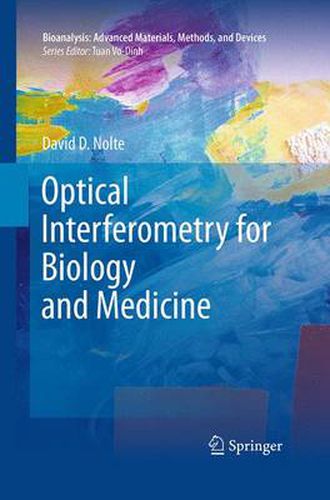Readings Newsletter
Become a Readings Member to make your shopping experience even easier.
Sign in or sign up for free!
You’re not far away from qualifying for FREE standard shipping within Australia
You’ve qualified for FREE standard shipping within Australia
The cart is loading…






This title is printed to order. This book may have been self-published. If so, we cannot guarantee the quality of the content. In the main most books will have gone through the editing process however some may not. We therefore suggest that you be aware of this before ordering this book. If in doubt check either the author or publisher’s details as we are unable to accept any returns unless they are faulty. Please contact us if you have any questions.
This book presents the fundamental physics of optical interferometry as applied to biophysical, biological and medical research. Interference is at the core of many types of optical detection and is a powerful probe of cellular and tissue structure in interfererence microscopy and in optical coherence tomography. It is also the root cause of speckle and other imaging artefacts that limit range and resolution. For biosensor applications, the inherent sensitivity of interferometry enables ultrasensitive detection of molecules in biological samples for medical diagnostics. In this book, emphasis is placed on the physics of light scattering, beginning with the molecular origins of refraction as light propagates through matter, and then treating the stochastic nature of random fields that ultimately dominate optical imaging in cells and tissue. The physics of partial coherence plays a central role in the text, with a focus on coherence detection techniques that allow information to be selectively detected out of incoherent and heterogeneous backgrounds.
Optical Interferometry for Biology and Medicine is divided into four sections. The first covers fundamental principles, and the next three move up successive scales, beginning with molecular interferometry (biosensors), moving to cellular interferometry (microscopy), and ending with tissue interferometry (biomedical). An outstanding feature of the book is the clear presentation of the physics, with easy derivations of the appropriate equations, while emphasizing rules of thumb that can be applied by experimental researchers to give semi-quantitative predictions.
$9.00 standard shipping within Australia
FREE standard shipping within Australia for orders over $100.00
Express & International shipping calculated at checkout
This title is printed to order. This book may have been self-published. If so, we cannot guarantee the quality of the content. In the main most books will have gone through the editing process however some may not. We therefore suggest that you be aware of this before ordering this book. If in doubt check either the author or publisher’s details as we are unable to accept any returns unless they are faulty. Please contact us if you have any questions.
This book presents the fundamental physics of optical interferometry as applied to biophysical, biological and medical research. Interference is at the core of many types of optical detection and is a powerful probe of cellular and tissue structure in interfererence microscopy and in optical coherence tomography. It is also the root cause of speckle and other imaging artefacts that limit range and resolution. For biosensor applications, the inherent sensitivity of interferometry enables ultrasensitive detection of molecules in biological samples for medical diagnostics. In this book, emphasis is placed on the physics of light scattering, beginning with the molecular origins of refraction as light propagates through matter, and then treating the stochastic nature of random fields that ultimately dominate optical imaging in cells and tissue. The physics of partial coherence plays a central role in the text, with a focus on coherence detection techniques that allow information to be selectively detected out of incoherent and heterogeneous backgrounds.
Optical Interferometry for Biology and Medicine is divided into four sections. The first covers fundamental principles, and the next three move up successive scales, beginning with molecular interferometry (biosensors), moving to cellular interferometry (microscopy), and ending with tissue interferometry (biomedical). An outstanding feature of the book is the clear presentation of the physics, with easy derivations of the appropriate equations, while emphasizing rules of thumb that can be applied by experimental researchers to give semi-quantitative predictions.